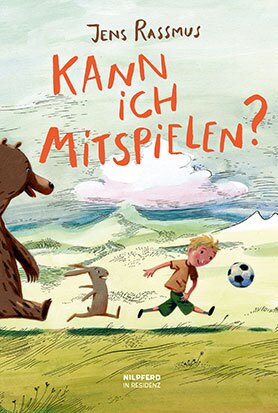Jens Rassmus
Kann ich mitspielen? Eine Fußballgeschichte
[Can I play too? A football story]
- Nilpferd im G&G Verlag
- Vienna 2014
- ISBN 978-3-7017-2134-4
- 48 Pages
- 5 Suitable for age 6 and above
- Publisher’s contact details
Jens Rassmus
Kann ich mitspielen? Eine Fußballgeschichte
[Can I play too? A football story]
Sample translations
The ball flies on... and on... and on... Jens Rassmus’ picture book story “Kann ich mitspielen?” [“Can I play too?”]
That’s how we played when we were children, and it’s still the same today: children play football, just for the sheer joy of it. It’s to do with nothing less than the joy of bustling around, the joy of competing, of playing, of engaging in a sport, the excitement offered by a small ball and a big adventure. And it’s to do with something that the children themselves are not necessarily aware of: the discovery and exploration of friendship, and even of their powers of empathy vis-à-vis people and situations.
This is precisely the theme that the author and illustrator Jens Rassmus so imaginatively interprets and expands on in his picture book “Can I play too? — A football story”, all of it centred on the primal joy of play. His story explores new horizons — quite literally — but it begins with exactly that classic situation mentioned above that is so familiar to children the world over: ‘Micky’s got a brand new football, but no one has time to play with him.’ There he is, the poor little chap, with his shy smile and his sense of being a bit lost, stuck in the bare, walled-in back yard of a block of flats in some anonymous town. Up against the wall two rubbish bins serve as his goal posts. 34-nil — that should do it! Just one more kick. But of all the stupid things that could happen, his ball goes flying over the wall.
And so begins the incredible adventure that Micky takes us on — assuming that we’re willing to go along with him. We simply need to clamber up onto one of the rubbish bins, made a little higher thanks to a sturdy box, stand on tiptoe, and peer over the wall — thereby looking beyond the first of many horizons.
In the story the ball doesn’t merely fly off randomly with more or less every kick into yet another unfamiliar world: it lands at the feet of living creatures that one might expect Micky to find prettty alien — a hare, a bear, a giant, a spider, a pigeon, an angel, and even a stone. They speak Micky’s language, and, like Micky himself, they all take great delight in one another’s company and in their game. There are no grand words, no grand gestures: it goes without saying that what matters above all else is the fact that they have come together; and it goes without saying that they accept their new companions’ differentness without the least demur. It seems only briefly surprising that a spider with its eight legs can juggle with the ball so fantastically well, that the bear can pull off a magnificent bicycle kick, or that even a stone can make an important contribution to the game.
Nothing could be simpler. In Grimm’s familiar fairy tale there are six characters who traverse the whole world — in this story there are eight of them conquering one horizon after another, then ultimately all landing together on a football pitch, where a pretty famous team in their blue and yellow kit appear to be awaiting the motley bunch’s arrival. Nothing could be simpler.
Using simple words and offering unexpected views of the worlds that exist beyond confining walls and beyond horizons both near and far, Jens Rassmus tells us a story that appeals to us much more than any evocation of divisiveness might do. He conveys his story through words, and through a wonderfully delicate and colourful succession of images big and small, in the process refraining from any kind of excessive embellishment in the form of pointless props or backdrops. In his artwork Rassmus uses a multi-colour technique with plenty of bright, friendly shades together with delicate pen-and-ink detailing. Only at the very start — in Micky’s constricted real-life world where the adventure begins — does grey dominate: the dismal grey of a high-walled back yard.
Many true stories begin exactly like this: a child all alone — sad perhaps, or bored — in a grey back yard, then suddenly a fantastic possibility opens up, ripe for exploitation by little Micky and by us, the reader. Reach up a little way, hold your balance for a little while, then marvel at the unfolding adventure that awaits us beyond the wall.
Translated by John Reddick

By Siggi Seuß
Siggi Seuß, freelance journalist, radio script writer and translator, has been writing reviews of books for children and young people for many years.
Publisher's Summary
Jens Rassmus makes our wildest football dreams
come true in this book – and we're cheering!
A very special football match – Everyone's playing! Michi has a new ball, but no one to play with. Just then Rubaldi the rabbit comes along. He may be a rabbit, but he sure loves playing football! Two players kicking a ball on a field is great, but three would be better. It doesn't take too long to convince Van Brummel the bear to play along. Then Lulatshish the giant joins the game, followed by Rosa Engel. Before long, Michi has a dream team for playing ball from the backyard to the field, from the mountains to the clouds, across the ocean and all the way around the world. The journey leads our team to a far away country with an enormous stadium…
(Text: Nilpferd im G&G Verlag)
